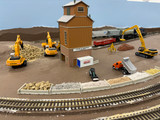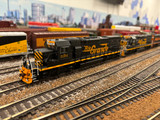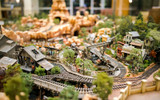Materials and Tools for Model Railroad Scenery
Model railroading is a beloved hobby that combines creativity, craftsmanship, and engineering to create miniature worlds that capture the beauty of trains and landscapes. One of the most captivating aspects of model railroads is the scenery, which brings the layout to life and adds realism and depth. To achieve stunning scenery on your model railroad, you'll need the right materials and tools. In this article, we'll explore some essential materials and techniques for constructing various elements of model railroad scenery.
Terrain Construction: Foam, Plywood, and Cardboard
The foundation of your model railroad scenery lies in the terrain construction. Various materials can be used to shape the landscape:
Foam:
Foam boards are a popular choice due to their lightweight and easily sculptable nature. Extruded polystyrene foam (XPS) or expanded polystyrene foam (EPS) can be carved, sanded, and painted to create hills, mountains, and other landforms.
Plywood:
Plywood serves as a solid base for your layout. It provides stability and support for the track and scenery. Plywood can be cut and layered to create elevation changes, and it offers a sturdy surface to attach various scenic elements.
Cardboard:
Cardboard can be used for building terrain contours, especially for smaller layouts. It's easily available, affordable, and can be shaped into hills, valleys, and cliffs with relative ease.
Ground Cover: Gravel, Ballast, and Static Grass
Realistic ground cover adds texture and authenticity to your model railroad scenery. Several materials can be used to simulate different ground surfaces:
Gravel:
Gravel can be used to represent rocky areas, roads, or pathways. It's available in various sizes and colors and can be glued in place with white glue or matte medium.
Gravel emerges as an essential element in model railroad scenery, offering a versatile solution to replicate various ground surfaces. From rocky pathways to roadways, gravel provides a convincing texture and appearance. Available in a range of sizes and colors, this material can be thoughtfully positioned and secured with adhesives to convey the ruggedness of landscapes. Its adaptability and ease of use make it a staple choice for modelers seeking to add a touch of authenticity to their layouts.
Ballast:
Ballast is crucial for creating realistic track beds. It's the crushed stone that holds the train tracks in place. Different sizes and colors of ballast can be applied along the tracks and secured with adhesive.
Ballast is a model railroad ground cover with a distinct purpose beyond aesthetics. It serves as the bed for train tracks, recreating the real-world crushed stone that stabilizes the rails. Modelers can select different ballast sizes and shades to mirror the specifics of the track they're replicating. Properly applied and adhered, ballast not only elevates the realism of the layout but also enhances the overall functionality and accuracy of the track system.
Static Grass:
Static grass adds a lifelike appearance to lawns, fields, and meadows. An electrostatic applicator charges the grass fibers, causing them to stand upright when applied to a glue-covered surface. This creates a three-dimensional and natural-looking effect.
Static grass takes model railroad scenery to another level, transforming flat expanses into lush landscapes. Using an electrostatic applicator, modelers can make grass fibers stand upright on a glue-covered surface, resulting in a three-dimensional, lifelike appearance. This technique mimics the varied heights of real grass, creating visually captivating fields, meadows, and lawns. Available in a spectrum of shades, static grass allows modelers to reflect different seasons and environments, granting a dynamic quality to the scene.
Trees and Foliage: Using Wire Armatures and Flocking
Trees and foliage contribute significantly to the realism of your model railroad scenery. Creating them involves wire armatures and flocking:
Wire Armatures:
Wire armatures serve as the skeletons of trees. Thin wires are twisted together to form branches, which are then coated with adhesive and covered with foliage material.
Model railroad trees and foliage crafted using wire armatures are a testament to the artistry and meticulousness of the hobby. Wire armatures serve as the foundation for these lifelike creations, allowing modelers to sculpt trees and plants with incredible detail and realism. Thin wires are skillfully twisted into intricate branches and trunks, mimicking the delicate structure of real flora. Once the armature is formed, it's coated with adhesive and adorned with various foliage materials, such as foam foliage or static grass. This step brings the wire armature to life, transforming it into a lush and vibrant element of the landscape. Through the use of wire armatures, model railroad enthusiasts can bring the beauty of nature to their layouts with a level of authenticity that captivates the eye and sparks the imagination.
Flocking:
Flocking refers to the process of applying fine, textured materials to represent foliage. Woodland Scenics, static grass, and foam foliage are commonly used for creating trees, bushes, and shrubs. These materials are attached to the wire armatures using adhesive.
Model railroad trees and foliage take on a new dimension with the technique of flocking. Flocking involves the application of fine, textured materials to wire armatures, creating a remarkable illusion of natural vegetation. This process adds depth, color, and texture, resulting in trees and bushes that exude a lifelike quality. By using materials like static grass and foam foliage, modelers can replicate the vibrant greenery found in real landscapes. Through meticulous application and layering, the subtle nuances of nature are effectively captured, allowing for a seamless integration of these miniature marvels into the model railroad scenery. Flocking stands as a testament to the dedication of model railroad enthusiasts to achieve the utmost realism in their creations, turning a simple wire frame into a testament to the art of replicating nature.
Water Features: Resin Pours and Acrylic Mediums
Adding water features like rivers, lakes, and ponds brings a dynamic element to your model railroad scenery:
Resin Pours:
Epoxy resins can be poured to create realistic water effects. Tint the resin with appropriate colors and pour it onto the designated area. It self-levels and dries clear, creating a convincing water surface.
Acrylic Mediums:
Acrylic gels and mediums can also be used to create water effects. These can be sculpted and shaped before they dry, allowing for more control over the water's appearance. Once dry, they provide a glossy finish resembling water.
Woodland Scenics:
Woodland Scenics offers a range of high-quality products designed to enhance model railroad scenery, including their innovative water solutions. Woodland Scenics water products enable modelers to create incredibly realistic water features such as rivers, lakes, and ponds on their layouts. These products, like the Water Effects and Realistic Water kits, provide a user-friendly way to achieve stunning water effects. Whether you're aiming for still, glass-like surfaces or gently flowing currents, Woodland Scenics water products offer versatility and ease of use. The materials dry clear and maintain their transparency, adding a touch of authenticity to your miniature landscapes. With Woodland Scenics water products, modelers can seamlessly integrate lifelike water elements, elevating the visual impact of their model railroad scenes.
Structures and Buildings: Kits vs. Scratch-Building
Incorporating structures and buildings adds urban or rural charm to your model railroad layout. You have the option of using kits or scratch-building from raw materials:
Kits:
Model building kits come with pre-cut parts and instructions. They're suitable for beginners and those who want to save time. Kits are available in various scales and styles, ranging from simple houses to complex industrial structures.
Model railroad structure kits offer enthusiasts a convenient and engaging way to add architectural diversity and character to their layouts. These kits come with pre-cut parts and detailed instructions, simplifying the building process for both beginners and experienced modelers. Whether you're looking to recreate a bustling urban scene or a tranquil rural setting, structure kits are available in various scales and architectural styles to suit any layout theme. From charming houses and storefronts to intricate industrial complexes, these kits provide a foundation for customization, allowing modelers to paint, weather, and detail structures according to their vision. With model railroad structure kits, hobbyists can quickly populate their landscapes with realistic and eye-catching buildings, enhancing the overall appeal and narrative of their miniature world.
Scratch-Building:
Scratch-building involves constructing structures from raw materials like plastic sheets, wood, and metal. This approach offers more creative freedom, allowing you to design unique buildings tailored to your layout's theme and era.
Model railroad scratch building is a captivating endeavor that empowers modelers to exercise their creativity and craftsmanship to the fullest. Unlike using pre-made kits, scratch building involves constructing structures and elements from raw materials such as plastic, wood, and metal. This approach offers a higher level of customization, allowing enthusiasts to design and build structures that perfectly align with their layout's theme, era, and unique vision. While it requires more time and skill, scratch building grants the freedom to experiment with various techniques and materials, resulting in truly one-of-a-kind pieces. From intricate architectural details to personalized weathering effects, scratch-built creations boast an unparalleled level of authenticity. Engaging in model railroad scratch building is not just a hobby; it's an artistic pursuit that allows individuals to shape their miniature worlds with unparalleled ingenuity.
In conclusion, crafting captivating model railroad scenery requires a combination of materials and techniques. From shaping terrain to creating lifelike foliage and incorporating water features, each element contributes to the overall realism and visual appeal of your layout. Whether you opt for ready-made kits or embrace the challenge of scratch-building, the world of model railroad scenery offers endless possibilities for creative expression.
Photo Courtesy of Employee and member of Central Iowa Railroad Club Jason Stiles
Recent Posts
-
All Aboard the Wisdom Express: Life Lessons from Model Railroading
Embarking on the journey of model railroading opens the door to a world where imagination meets prec
-
Capturing History in Miniature: The Art of Prototype Modeling in the Model Railroad World
Prototype modeling in the model railroad world involves creating miniature replicas of real-life tra
-
Unveiling the Imaginative World of Fictional Railroads: Where Creativity Meets the Rails
Model railroading has long been a hobby rooted in historical accuracy and meticulous attention to de




